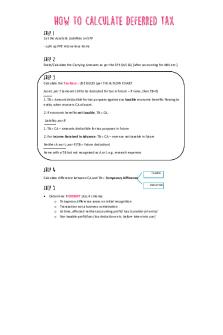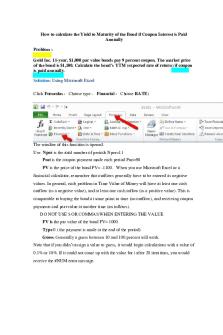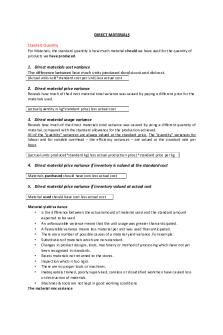WBGT exercises memo - How To calculate the Wet Bulb Globe temperature Index PDF

| Title | WBGT exercises memo - How To calculate the Wet Bulb Globe temperature Index |
|---|---|
| Course | Occupational Health And Safety 2: Assessment |
| Institution | Cape Peninsula University of Technology |
| Pages | 6 |
| File Size | 400.9 KB |
| File Type | |
| Total Downloads | 10 |
| Total Views | 149 |
Summary
How To calculate the Wet Bulb Globe temperature Index...
Description
How do I calculate the WBGT Index? The wet bulb globe temperature (WBGT) is calculated by using the following equations.
For outdoors with direct sun exposure: WBGT = 0.7 x Tempwet bulb + 0.2 x Tempglobe + 0.1 x Tempair
For indoors or outdoors without direct sun exposure: WBGT = 0.7 x Tempwet bulb + 0.3 x Tempglobe
where: Tempwet bulb natural wet bulb temperature measured by using a thermometer whose bulb is covered with wet cotton cloth and is cooled by the natural air movement Tempglobe temperature measured using a black globe thermometer Tempair temperature measured using a conventional thermometer All temperatures are to be expressed in °C. Example Workers employed in an outdoor workplace with direct exposure to the sun. Measurement of workplace conditions produced the following results. Tempwet
bulb
= 24°C
Tempglobe = 42°C Tempair = 40°C WBGT = 0.7 x 24 + 0.2 x 42 + 0.1 x 40 = 29.2°C Time-Weighted Average (TWA) When thermal conditions of the workplace fluctuate widely, time-weighted average (TWA) WBGT is used to assess heat exposure.
WBGT1,WBGT2, etc. the wet bulb globe temperatures measured or calculated t1, t2, etc. the elapsed time spent in the corresponding conditions described by WBGT1, WBGT2, etc., respectively. Example Measurement and/or calculation of WBGT during a two-hour job produced the following results.
Exposure duration WBGT (hours) (°C) 0.5 25 1.0 27 0.5 28 These data would yield the following time-weighted average.
Example Problem The following is an example using the WBGT Calculator post-incident to determine if there was potentially a heat hazard present during an incident. The details are based on a real incident discussed in the NIOSH Criteria for a Recommended Standard: Occupational Exposure to Heat and Hot Environments. As thoroughly as possible, determine if there were heat hazards present in the following example. Example: In Toledo, Ohio, on June 8, 2002, at 4 pm, a 30-year-old male landscaper mowingassistant collapsed and died of heat stroke after a day of caring for residential lawns [NIOSH 2002]. Post-incident interviews indicate the worker complained of feeling light-headed and short of breath two hours before his death, but he refused assistance offered to him by his partner. Others said that the worker was on medication that had a warning about exposure to extreme heat, and this might have interfered with body temperature regulation. The landscape worker was wearing two pairs of work pants on the day he died, but his partner did not notice any profuse sweating or flushed or extremely dry skin. Interviews with the emergency responders indicate that when the worker collapsed, emergency medical services (EMS) treated the victim at the site, and then transported him to the hospital. At the hospital he was pronounced dead with an internal temperature of 42°C (107.6°F). Answer: Since wind, humidity, and barometric pressure site measurements are not given in this example problem, the historical data was found online at Weather Underground by entering the location and date.
Given and Assumptions
Date of Incident: June 8, 2002
Air Temperature: 77°F (25°C) – From Weather Underground
Cloud Cover: Clear – From Weather Underground
Wind Speed: 4.6 mph – From Weather Underground
Relative Humidity: 56% - From Weather Underground
Time: 2 pm The worker's symptoms began two hours before his death at 4:00 pm
Barometric Pressure: 30.13 in Hg - From Weather Underground
Clothing Adjustment Factor (CAF): 3 – From Table 3
Step 1: Determine WBGT Use historic weather data and enter it into the Argonne National Laboratory WBGT estimation calculator. Using Table 1, solar irradiance for clear/sunny may be estimated as 990 W/m
Step 2: Determine WBGT eff WBGTeff = WBGTout + Clothing Adjustment Factor (CAF) (Use Celsius)
2
The worker's two pairs of work pants fall under the double layer woven clothing in Table 2; therefore, the Clothing Adjustment Factor (CAF) is 3. Table 2. Clothing Adjustment Factors Clothing Worn
CAF
Work clothes (long sleeves and pants). Examples: Standard cotton shirt/pants.
0
Coveralls (w/only underwear underneath). Examples: Cotton or light polyester material.
0
Double-layer woven clothing.
3
SMS Polypropylene Coveralls
0.5
Polyolefin coveralls. Examples: Micro-porous fabric (e.g., TyvekTM).
1
Limited-use vapor-barrier coveralls. Examples: Encapsulating suits, whole-body chemical protective suites, firefighter turn-out gear.
11
Adopted from: ACGIH "2017 TLVs and BEIs" TABLE 1 WBGTeff = 25.5°C + 3 WBGTeff = 28.5°C Step 3: Determine the metabolic work rate Lawn care falls under "Heavy work" on Table 3, as it requires intensive, repetitive work and heavy material/equipment handling. Using Table 3, Metabolic Rate = 415 Watts Table 3. Metabolic Work Rates Work Category
Metabolic Rate (Watts)
Examples
Rest
115
Sitting
Light
180
Sitting, standing, light arm/hand work and occasional walking
Moderate
300
Normal walking, moderate lifting
Heavy
415
Heavy material handling, walking at a fast pace
Very Heavy
520
Pick and shovel work
Adopted from: ACGIH "2017 TLVs and BEIs" TABLE 3 Figure 5. ACGIH TLV & Action Limit Source: ACGIH "2017 TLVs and BEIs" FIGURE 2
Step 4: Determine if exposure was above the Threshold Limit Values Using Table 3, metabolic rate at 415 and 28.5°C WBGTeff in Figure 4, the TLV (27°C) was exceeded indicating that the worker was exposed to excessive heat stress at the time of death. Other factors in this example indicate the victim was exposed to excessive heat stress at the time of his death. The worker’s core temperature at death was 42°C. Additionally, the victim experienced heat stress symptoms; he was light-headed and short of breath.
EXERCISE 3 Example Suppose it’s a bright sunny day and a crew of roofers is working 20 feet above ground. Our assessment yields the following readings: Wet bulb temperature (cooling effects of evaporation) = 20°C Black bulb globe temperature (radiant heat) = 36°C Dry bulb temperature (air temperature) = 33°C Using the formula for work in direct sunlight, we calculate as follows: WBGT = (0.7 x wet bulb temperature) + (0.2 x black bulb globe temperature) + (0.1 x dry bulb temperature) = (0.7 x 20) + (0.2 x 36) + (0.1 x 33) = 14 + 7.2 + 3.3 WBGT (outdoors) = 24.5 °C...
Similar Free PDFs

How to Calculate Beta
- 2 Pages

How to Calculate Deferred Tax
- 3 Pages

How to Calculate your GPA
- 1 Pages

How to Calculate GST in a Flash
- 2 Pages

Wet to moist dressing change
- 2 Pages
Popular Institutions
- Tinajero National High School - Annex
- Politeknik Caltex Riau
- Yokohama City University
- SGT University
- University of Al-Qadisiyah
- Divine Word College of Vigan
- Techniek College Rotterdam
- Universidade de Santiago
- Universiti Teknologi MARA Cawangan Johor Kampus Pasir Gudang
- Poltekkes Kemenkes Yogyakarta
- Baguio City National High School
- Colegio san marcos
- preparatoria uno
- Centro de Bachillerato Tecnológico Industrial y de Servicios No. 107
- Dalian Maritime University
- Quang Trung Secondary School
- Colegio Tecnológico en Informática
- Corporación Regional de Educación Superior
- Grupo CEDVA
- Dar Al Uloom University
- Centro de Estudios Preuniversitarios de la Universidad Nacional de Ingeniería
- 上智大学
- Aakash International School, Nuna Majara
- San Felipe Neri Catholic School
- Kang Chiao International School - New Taipei City
- Misamis Occidental National High School
- Institución Educativa Escuela Normal Juan Ladrilleros
- Kolehiyo ng Pantukan
- Batanes State College
- Instituto Continental
- Sekolah Menengah Kejuruan Kesehatan Kaltara (Tarakan)
- Colegio de La Inmaculada Concepcion - Cebu










